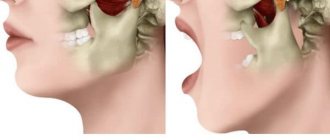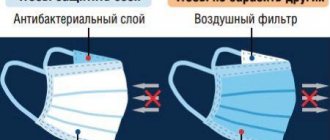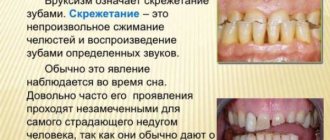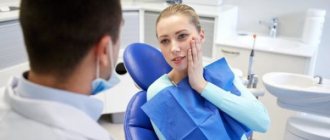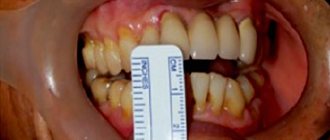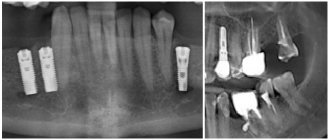Causes
When pain occurs in the cheekbone or jaw area near the ear, this may indicate diseases of the soft tissues of the face, inflammation of the lymph nodes, ears, sinuses, gums and teeth. Before you see a doctor, you need to choose the right specialist: an otolaryngologist, a dentist or a surgeon. First, you should make an appointment with a therapist and tell him about your complaints. For correct diagnosis, laboratory and clinical tests are prescribed.
Reasons why the jaw hurts near the ear on the left and right sides, accompanied by pain when chewing:
- Pathologies of the temporomandibular joint, gums, and dental apparatus. This is the specialization of dentists and maxillofacial surgeons. A dental surgeon will also help when it comes to such serious processes as phlegmon and jaw abscess.
- Inflammatory process in the nasal sinuses. The maxillary sinuses are located in the lateral region of the nose. There is a cavity behind the ear. It approaches the process of the temporal bone. The mucous membrane sometimes becomes inflamed, as evidenced by aching pain in the cheekbones. In this case, assistance is provided by an otolaryngologist.
- Inflammation of the tonsils, larynx and surrounding tissues. The disease is provoked by a purulent-inflammatory process. Pain often appears after an infectious disease or tumor. In such cases, you must contact an ENT doctor.
- Diseases of the peripheral nervous system. An inflammatory process occurs in nerve tissues. Pain appears, for treatment of which you should consult a neurologist or therapist.
- Inflammation of the lymph nodes. Sometimes lymph from the larynx, nose or ears, infected with pathogens, enters the tissues. In adults, this disease is treated by a therapist. If we are talking about a child, you need to go to the pediatrician.
Blown ear: Causes
The main cause of the inflammatory process in the ear is a cold, which is the result of an infection in the organs of the nasal system against the background of reduced immunity (ARVI, characterized by lethargy, fatigue, headache, nasal congestion, cough, tickling). However, there are other reasons:
- A sharp flow of air into the hearing organs while driving a car (when opening a window and strong wind) or riding a motorcycle (without a protective helmet);
- Sleeping at night with the window open, the air conditioner or fan turned on (a person’s body temperature decreases during sleep, if the room temperature is below 18 degrees, it will blow);
- Hardening without preparing the body (before dousing with ice water, the body needs to get used to it using a contrast shower).
As a rule, a person does not attach much importance to discomfort in the ear area. But as the pain increases, it is difficult to ignore the unpleasant symptoms. If a person ignores them, the inflammatory process has time to spread. If you have a blown ear, you should not wait for self-healing. The use of modern treatment tactics helps prevent complications and also reduce the duration of therapy.
The result of a blown ear is the appearance of an inflammatory process. There are several pathologies associated with the formation of severe pain in the ear.
There are 3 types of otitis - external (auricle, external auditory canal and eardrum), middle (middle ear cavity), internal (inner ear).
Furuncle is an inflammation of the sebaceous gland or hair follicle of the skin of the membranous-cartilaginous part of the outer ear or auricle. When mature, it produces symptoms:
- Itching (irritation, burning and tingling in the ear)
- Sharp pain when touched;
- Swelling and redness of the boil;
- Enlarged cervical lymph nodes;
- General intoxication (poisoning by waste products of bacteria, viruses);
- Hearing impairment.
The patient receives relief after the boil breaks through and pus comes out.
Appears after the ear has been blown, under the influence of fungal microorganisms. The outer part of the ear is more often affected than the middle part.
Among other things, the patient experiences weakness, fatigue, and general malaise in the evenings and at night.
What are the dangers of untimely treatment?
If you delay a visit to the doctor, more complex pathologies may arise:
- inflammatory and purulent processes in tissues;
- infectious diseases of the ears, nose and mouth;
- imbalance of electrolytes and problems with metabolism in tissues;
- tumors of various etiologies;
- inflammation of nervous tissue and peripheral vessels.
If jaw pain appears after visiting the dentist, you should seek help from the same specialist. However, if the problem arose not after tooth extraction, but as a result of the installation of a brace system, the pain is considered normal. This condition goes away on its own within 2 months. If its intensity does not decrease, then a consultation with the attending orthodontist would not hurt.
It is necessary to contact a trauma surgeon if pain in the jaw and cheekbones appears after an injury. Unpleasant sensations can be a consequence of both a regular bruise and a dislocation, fracture and abscess.
Therapeutic measures
After diagnostics are carried out, which helps to establish the true cause of the pathological process, the specialist prescribes treatment:
- For jaw injuries, external anti-inflammatory agents, painkillers, and fixation (for fractures) are used.
- Radiation therapy, chemotherapy, and surgery are used to treat tumors.
- For infectious and inflammatory processes, antibiotic therapy, compresses, mouth rinsing, and surgical treatment are used.
Also, depending on the causes of the disease, physiotherapy is used:
- Microwave therapy is prescribed for diseases of the ENT organs, skin diseases, and degenerative changes. This method reduces muscle spasm, relieves inflammation, improves local blood circulation, and has an analgesic effect.
- UHF therapy is used for inflammatory diseases affecting the musculoskeletal system, ENT diseases, neuritis, and abscess. Courses of treatment accelerate tissue healing, relieve pain, reduce swelling, and improve blood and lymph circulation.
- Ultraviolet irradiation is useful for arthritis, arthrosis, neuralgia, and skin diseases. The procedures strengthen the immune system, accelerate metabolism, relieve pain and inflammation, and improve the regeneration of bone and nerve tissue.
- Diadynamic therapy is indicated for pain syndromes of various origins and joint diseases. It has an analgesic effect, improves blood and lymph circulation, stimulates muscle tissue, and accelerates the healing process.
If the discomfort continues for a long period, you should immediately contact a specialist. Soreness in the jaw and ear indicates the development of many serious diseases, which are impossible and dangerous to diagnose and treat on your own.
The bone near the ear hurts when pressed
There are two possible options here: inflammation of the nerve endings or dental diseases. If pain appears in the jaw bone near the ears or in the muscles, it may be due to the following reasons:
- Injury. The integrity of the facial bones is compromised if a person receives a strong blow to the head. At the same time, it is accompanied by a constant aching pain that intensifies when pressed.
- The appearance of a wisdom tooth. When it erupts, painful sensations are not uncommon. Some experience less discomfort, while others experience significant pain when pressing on the cheekbones.
- Osteomyelitis of the jaw. The pathology extends to the entire bone. Pathogenic microbes provoke the onset. They penetrate into the root canals. The pain can be quite strong and aching.
- Pulpitis, caries. The pain in these diseases increases in the morning (after sleep) and at night. It is clearly felt when pressing on the cheekbone in the affected area.
- Arteritis. The pain occurs in the jaw area and is usually burning.
- Violation of the functional characteristics of the temporomandibular joint. Pain is felt not only when pressing, but also when a person opens his mouth and chews food.
- phlegmon, abscess, fistulas, boils. A common symptom of these ailments is pain when pressing on the jaw at rest.
The nature of pain and the mechanism of its occurrence
When it is painful to open your mouth wide, or it is completely jammed, this almost always indicates an inflammatory process, a violation of the anatomy and functions of tissues. The pain can spread to all areas of the face, shoot into the ear, cause migraines, and discomfort with visual strain. It can be different - long-term and short-term, aching and acute, which is taken into account when making a diagnosis.
Aching pain in the lower jaw accompanies the inflammatory process, and burning pain occurs with neuralgia. Cutting pain is usually diagnosed as a bone injury. People who find it painful to chew or open their jaws wide often blame pathology of the skeletal system as the cause. However, the disease can also affect surrounding tissues. If the patient ignores the pain, unpleasant symptoms will soon occur even with the jaw closed.
Under the influence of certain diseases, the jaw can jam and hurt on the left or right side. Pain on the left side may indicate poor circulation or problems with the blood vessels of the heart. Its right-sided nature is observed in neoplasms and inflammatory processes. If your jaw hurts everywhere and constantly, you can suspect an oncological factor.
It happens that the jaw cramps after sleep, and in the morning, at rest, cramps appear. You should not delay your visit to the doctor. Especially if the disease is accompanied by the following symptoms:
READ ALSO: cramping of the lower jaw: causes and treatment
- spasms with fever,
- throbbing pain with spasms,
- severe pain radiates to any ear, eye (we recommend reading: what to do if toothache radiates to the ear?),
- swelling,
- mouth doesn't open
- it hurts to chew for a long time,
- cramps in the lower part of the face.
READ ALSO: what to do if your mouth cannot open after wisdom tooth removal?
When you open your mouth
Pain when opening the mouth is a consequence of a dislocation or fracture. If there has been no recent injury, these options are excluded. In this case, the cause of discomfort is osteomyelitis. Other pathologies that lead to sharp, aching or acute pain when working the jaws are dental diseases, among which caries ranks first. This also happens when dentures are installed incorrectly.
When chewing and closing teeth
If the jaw system aches, ache, bothers you when chewing or connecting teeth, you can suspect its dislocation or osteomyelitis. Other ailments that lead to discomfort when closing teeth include periodontitis, pulpitis, and complicated caries. When they exacerbate, the pain is pulsating in nature, radiates to the temple, and intensifies during moments of rest and night rest.
In the chronic form of pathologies, periodic aching pain is possible, which worsens with chewing load on the affected tooth or gum area. Certain foods and alcohol can also provoke discomfort when chewing. Leading to spasm of the esophagus, they also cause muscle spasm and jamming of the jaw.
Pressure
Pain in the cheek area when pressed has various causes. It can appear near the right or left side of the ears, or occur when palpating the upper or lower part. The cause of burning is often arteritis of the facial artery. With phlegmon, fistulas and abscess, the jaw will hurt even with a light touch at rest, and this symptom will be accompanied by others that cannot be ignored.
Pain when pressing on the teeth and gums indicates their pathology and dental problems. It often worries when there is abnormal eruption of a wisdom tooth, as well as accidental injury to the jaw.
Jaw crunches and hurts
Some people experience a cracking jaw when yawning. But besides this, sometimes there is pain. It continues for a long time, manifests itself when chewing food, opening the mouth, and even at rest.
If such pain does not go away the next day, this may indicate the presence of diseases:
- bursitis;
- jaw arthritis;
- dislocation of the jaw joint;
- sprain in the jaw muscle.
When you see a doctor with such symptoms, he sends the patient for an X-ray. If it turns out that the joints are healthy, the patient is referred to UHF or prescribed non-steroidal anti-inflammatory drugs. Treatment takes a week. Physiotherapeutic procedures in combination with painkillers promote recovery.
Consequences
If treatment is incorrect or untimely, the patient develops the following consequences:
- Increased pain when moving or listening to loud music;
- Disturbance in the functioning of part of the inner ear (vestibular apparatus);
- The appearance of hearing loss, partial or complete hearing loss;
- Meningitis (inflammation of the membranes of the brain and spinal cord);
- Encephalitis (inflammation of the brain).
Basically, inflammation affects the meninges, thereby leading a person to a wheelchair or death. The child may experience developmental delays due to insufficient stimulation of certain areas of the brain. Therefore, if your ear is blown out, you should immediately consult a doctor. Only an otolaryngologist is able to accurately diagnose and prescribe the correct treatment, preventing serious consequences.
The joint clicks and hurts
It happens that when you open your mouth, a click is heard, accompanied by a feeling of discomfort. This phenomenon is explained by the exit of the jaw joint from the articular capsule. He moves to the side. As soon as he manages to return to his place, a crunch is heard.
Often the cause is an injury. Clicking with pain can provoke tension in the jaw muscle during singing and talking, and an incorrect bite.
What to do in this case:
- Timely diagnosis. To determine the first cause correctly, it is important to seek medical help in time. The specialist prescribes magnetic resonance imaging, arthroscopy and radiography.
- If the function of the jaw joint is impaired, consult a dentist. The doctor will carry out long-term work aimed at re-filling the tooth or correcting the bite, replacing dentures, etc. At the same time, a course of anti-inflammatory drugs will be prescribed.
- Until you see a specialist, you can alleviate the condition at home by applying a warm compress. If the affected area becomes inflamed, ice should be applied. For the entire period of treatment, you should avoid rough foods and give preference to soft, ground foods. It is necessary to talk less and generally provide complete rest to the affected joint.
- Use relaxation techniques. Tibetan hormonal gymnastics and similar methods will help cope with pain or reduce its intensity.
The treatment method for diseases associated with clicking and pain in the jaw joints is determined by the nature of the inflammatory process and the degree of its neglect. The general recommendation is to ensure complete rest for the affected area.
Causes of non-infectious pain
In these cases, called otalgia, an adult experiences pain in the ear, but there is no inflammation:
- water getting into the ear. If microorganisms get in with the water, otitis may occur;
- acoustic injuries that occur during prolonged exposure of the hearing organ to loud music and loud sounds when using headphones and in noisy industries. Drug treatment is not required to relieve pain. You need to remove the source of noise and use earplugs in the future;
- exposure to strong wind and cold;
- foreign body;
- sulfur plug;
- barotrauma during diving or air travel. To get rid of unpleasant sensations, you can yawn, swallow, or use lollipops.
What does an increase in temperature indicate?
It all depends on the localization. For pain in the upper jaw, it can be:
- Osteomyelitis of the upper jaw. Caused by improper treatment of sinusitis, tooth removal or extraction, unsuccessful sinus lift and implant installation. The pain may radiate slightly to the left jaw or to the right.
- Sinusitis. Most often develops on one side. It is provoked by injuries to the nose or skull, prolonged exposure to the cold, pulpitis of the upper molars or periodontitis. Unpleasant sensations occur in the jaw and eye socket. The point of maximum sensitivity is marked near the nose. Pus or mucus flows from both nostrils or one of them. At the same time, it blocks half of the nose. The voice becomes nasal.
- Gingivitis. Inflammation of the mucous membrane of the gums leads to an increase in temperature and unpleasant sensations. The pathology extends to the entire jaw area. At the same time, bad breath appears.
- Alveolitis. Painful sensations are caused by the fact that after tooth extraction, its socket becomes inflamed.
For pain in the lower jaw:
- Submandibular abscess or phlegmon.
- Glossitis. Accompanied by inflammation of the mucous membrane of the tongue. It is a consequence of burns - thermal or chemical, as well as infection and injury. A person’s jaw ache, he ceases to feel the taste of food. His tongue hurts.
Also, localization under the jaw indicates the possible development of the following ailments:
- Submandibular lymphadenitis. Lymph nodes become inflamed when a person suffers from sore throat, conjunctivitis, periodontitis, or furunculosis. The diagnosis is confirmed based on tenderness and elasticity of the lymph nodes. They can be easily felt and are mobile. If they are hard to the touch and do not move, a consultation with an oncologist is required.
- Infectious mononucleosis. The disease is viral in nature. Accompanied by damage to a group of lymph nodes located under the lower jaw. The temperature rises, but the symptoms of intoxication are mild.
- Sialolithiasis. The functioning of the salivary glands is disrupted. Solid inclusions are determined in them. Swelling is detected on the right or left. A small amount of pus is released into the oral cavity. A person does not notice this, but his presence is felt through stale breath.
- Sialadenitis. The salivary glands become inflamed. The temperature rises and the secretion of saliva increases. A person's appetite decreases and weakness appears. A painful formation is clearly felt at the angle of the jaw.
- Pharyngitis. There is inflammation of the mucous membrane of the throat. A cough, pain radiating to the jaw, and sore throat appear.
Osteoid osteoma
Pain in one of the jaws is almost always observed only at night. For a long time there are no other symptoms; with sufficient growth of this malignant tumor, facial asymmetry becomes noticeable.
In this case, the pain spreads from the chin and lower jaw to the upper lip. The pain is severe, burning.
This symptom requires a more detailed analysis, depending on the location.
These may be the following pathologies (almost all symptoms are discussed above):
- Osteomyelitis of the upper jaw. It is associated with tooth extraction, improper treatment of sinusitis, tooth extraction, installation of an implant in the upper jaw, and incorrect sinus lift. It can hurt either in the left jaw or on the right.
- Sinusitis. Usually this disease develops on one side - right or left. It is provoked by hypothermia, trauma to the nose or skull, pulpitis of the upper molars, and periodontitis of the upper jaw. Symptoms of the pathology: pain radiates to the jaw, head, or eye socket, but you can find the point of maximum pain near the nose. In addition, half of the nose is blocked, mucus or pus flows from it (or from both nostrils), the voice becomes nasal, and mucus flows down the back wall of the throat.
- Cellulitis or abscess in this area, accompanied by swelling and tenderness of the soft tissues. The disease is preceded by an open (with deprivation of the integrity of the skin) wound of this area, a boil or treatment of the teeth of the upper jaw.
- Gingivitis is inflammation of the mucous membrane of the gums. Inflamed gums, and with them the entire jaw, hurt, the temperature rises, and bad breath appears. Read more about the symptoms and treatment of gingivitis.
- Alveolitis is an inflammation of the tooth socket after its removal.
Pain in the lower jaw with increased temperature may be a consequence of:
- osteomyelitis;
- gingivitis;
- alveolitis – complications after tooth extraction;
- submandibular phlegmon or abscess;
- glossitis - inflammation of the mucous membrane of the tongue, which occurs as a result of its infection due to burns (chemical or thermal) or injuries. With this disease, not only the tongue hurts and the taste ceases to be felt, but also the jaw aches;
- if it is localized near the ear and is accompanied by an increase in body temperature, it is most likely otitis media. In this case, there may be discharge of pus or light fluid from the ear, and hearing impairment. Otitis media is indicated by weakness, fatigue, loss of appetite. A characteristic symptom: the pain intensifies when pressing on the tragus of the ear (a particularly protruding cartilage on the inside).
The symptom of pain in the ear and jaw indicates:
- dysfunction of the temporomandibular joint. People over 30 years of age are more susceptible to this disease, especially those who have suffered trauma, arthritis of this joint, or have a pathology of the bite or masticatory muscles. It manifests itself as a headache in one half of the head, pain in the jaw, which radiates to the cheek, forehead, and temple. Jaw movements occur along a disturbed trajectory. With active movements of the jaw, a crunching and clicking sensation is felt in the joint near the ear. The jaw may suddenly lock.
- arthrosis of the temporomandibular joint. Here the pain is constant, aching. There is a crunching sensation when you open your mouth. Opening wide becomes painful, as does closing your jaw too tightly. Chewing on this side also hurts. It is especially difficult to open your mouth in the morning, but then it becomes easier.
- arthritis of the temporomandibular joint. Leading symptoms: pain near the ear, crackling, noise, clicking, crunching in the joint area, poor mobility, especially in the morning.
- otitis, that is, inflammation of the ear: external or middle, located deeper than the eardrum;
- carotidynia - irritation of the nerve endings near the carotid artery. This pain is paroxysmal, begins in the upper jaw, radiates to the neck, ear, oral cavity, and spreads throughout the face. Pressure on the side of the neck from the side and just below the Adam's apple causes acute pain. Causes of carotiditis: migraine, soft tissue tumors located near the carotid artery, temporal artery dissection;
- neuralgia of the ear node. In this case, paroxysmal burning pain occurs. This pain goes from the temple, past the ear, reaches the lower jaw, chin, and radiates to the teeth. Clicking in the ear also appears, and salivation increases. The cause of the condition is hypothermia, tonsillitis, sinusitis;
- erythroothalgia syndrome. Here the ear hurts more, not the jaw. The pain radiates to the forehead, lower jaw, and back of the head. In addition, the ear turns red. Causes of the syndrome: cervical spondylosis, dysfunction of the temporomandibular joint, damage to the thalamus and some others.
We suggest you familiarize yourself with how much time you need to brush your teeth: how many minutes should be given to children and adults
We suggest you read: Osteomyelitis of the upper jaw, symptoms, treatment
Pain in the jaw when chewing is a sign of:
- dysfunction of the temporomandibular joint;
- arthritis of this joint;
- arthrosis of the temporomandibular joint.
All these diseases are described in detail above.
Also, pain when chewing can occur with adamantinoma, one of the benign tumors that develops in the thickness of the lower, and less commonly, the upper jaw. The jaw increases in size, making it difficult to chew. At the same time, pain appears and increases.
Pain under the jaw is a sign of many diseases:
- Submandibular lymphadenitis. This is the name for inflammation of the submandibular lymph nodes. This happens when an infection gets here due to tonsillitis, periodontitis, conjunctivitis, facial furunculosis, or a carbuncle that appears on the face. To confirm the diagnosis, painful, elastic and mobile lymph nodes are palpated here. If the latter has a hard consistency, does not move or is painless, you need to look for where the cancer is metastasizing from.
- Infectious mononucleosis. This is a viral disease that affects many groups of lymph nodes, including the submandibular one. The pathology is accompanied by a rise in temperature and mild symptoms of intoxication (weakness, drowsiness, nausea, loss of appetite). Read more about infectious mononucleosis in children.
- Glossalgia or hypersensitivity of the tongue. Here the pain radiates to the lower jaw and occurs after chewing rough food, as well as eating sour, spicy, hot or cold foods.
- Glossitis is inflammation of the tongue. The tongue is noticeably thickened and bright red. If the pathology is not treated, submandibular phlegmon or an abscess may develop.
- Sialadenitis is inflammation of the salivary glands located under the jaw. In this case, the temperature rises, weakness appears, salivation increases, and appetite decreases. A dense elastic painful formation is determined at the angle of the jaw.
- Sialolithiasis. In this case, stones are detected in the salivary glands. Under the lower jaw - on the left or right - a swelling is detected, purulent discharge is released into the mouth, the amount is insignificant, and the person does not feel it, but the smell in the mouth becomes unpleasant.
- Pharyngitis is inflammation of the mucous membrane of the throat. Symptoms: sore throat, cough and pain that can radiate to the jaw.
- Sore throats are inflammations of the tonsils. In this case, the throat hurts greatly, the temperature rises, and it becomes painful to swallow. Pain from the throat can radiate to the jaw and ear.
- Tumors of the salivary glands, which are manifested by aching pain of low intensity, localized under the jaw. If the tumor is malignant, the pain becomes more intense, the temperature rises, the submandibular lymph nodes enlarge, weakness increases, and body weight decreases.
- Tumors of the larynx, in which the laryngeal nerve is irritated. In this case, pain appears in the throat, it spreads to the chest, the area under the lower jaw, and the ear. A person is also bothered by a lump in the throat, difficulty swallowing first solid and then liquid food.
- Fracture of the lower jaw. Its symptoms are described below.
Pain when opening the mouth can be:
- acute, when it occurred sharply and suddenly;
- chronic: exists for a long time.
Pain during ARVI and tooth extraction
When a person suffers from respiratory diseases, the infection spreads throughout the body. An inflammatory process develops, accompanied by painful sensations. This is why your cheekbones and jaw may hurt when you have a runny nose, colds or other viral diseases.
Please note the following facts:
- If the pain is localized in the cheekbone area almost under the eye, this indicates the development of sinusitis. It is necessary to contact an otolaryngologist.
- If the unpleasant sensations are localized in the area between the lower and upper jaws, a runny nose or cold may be to blame. Viruses and bacteria move into the joint sac, causing inflammation on its surface. As in the previous case, the problem is solved by contacting an ENT specialist.
- A cold provokes inflammation of the jaw nerve. In such cases, it makes sense to go to a neurologist.
- If you have an ear infection, your cheekbones may also hurt. Often this condition is accompanied by an increase in temperature. For treatment, the person is referred to an otolaryngologist.
- After tooth extraction, slight pain in the jaw appears. If it does not subside over time, the surgeon may not have completely removed the diseased tooth. It is necessary to contact a more qualified dentist to correct this poor quality work.
An ambulance should be called when the pain is sharp and unbearable. This happens when the jaw is fractured or dislocated.
Not only with otitis media, pain in the ear is combined with discomfort in the jaw area. This also indicates diseases such as:
- carotidynia. Nerve endings located near the carotid artery become irritated. Paroxysmal pain develops. It is most felt in the upper jaw and spreads to the ear, neck, oral cavity, and spreads to the face. When pressing on the side of the neck and just below the Adam's apple, it causes acute pain. The syndrome is provoked by migraine, soft tissue tumors located near the carotid artery. Carotidynia is also the result of temporal artery dissection;
- neuralgia of the ear node. The pain is burning, paroxysmal. It starts at the temple and passes through the ear, continuing to the lower jaw and chin. It is slightly felt in the teeth. There are clicks in the ear and increased salivation. It is provoked by sinusitis, sore throat, and if the face is blown while walking in windy weather;
- erythroothalgia syndrome. The jaw hurts slightly, but the maximum discomfort is felt in the ear. It turns red. The lower jaw and the back of the head hurt, spreading to the forehead. The syndrome occurs as a result of dysfunction of the temporomandibular joint, cervical spondylosis and damage to the thalamus.
Neuralgia and vascular pathologies
Damage to some nerves can give a negative picture, accompanied by pain in the joint near the jaw. Most often, problems occur with four nerves:
- trigeminal - inflammation is characterized by burning pain on one side of the jaw, most often on the right near the ear;
- upper laryngeal - pain in the lower jaw;
- glossopharyngeal - in this case the pain spreads throughout the lower part of the face from the tongue to the jaw;
- occipital - radiating, so-called deceptive pain in the jaw near the ear from the back of the head.
Major nerves and muscles of the face
In the video, Elena Malysheva talks about trigeminal neuralgia:
The cause of severe pain may also be vascular disorders. Most often, this is a lesion of the carotid artery, which affects not only the neck and lower jaw, but also half of the face on the left or right.
Arteritis of the facial artery can be accompanied by pain in both jaws or along the edge of the lower jaw with discomfort radiating to the wings of the nose, lip and ear area. Arteries are responsible for supplying the brain with oxygen and nutrients. Any vascular pathology can cause disturbances in blood flow in this area.
Pain in the jaw, radiating to the facial and ear areas, can be a harbinger of future brain damage - a stroke.
TMJ dysfunction
Functional diseases of the temporomandibular joint are accompanied by pain in the area of the jaw joints near the ear when talking, opening the mouth wide and chewing. They can be recognized by other signs:
- the amplitude of mouth opening is limited;
- the jaw gets stuck in the open or closed position;
- when trying to talk, grinding, crackling and clicking noises are heard;
- increased fatigue of facial muscles;
- periodically there are sensations that the upper and lower rows of teeth do not meet correctly;
- one side of my face is swollen.
Sometimes ringing in the ears, hearing loss, and dizziness occur.
Data from the patient’s complaints, a panoramic X-ray of the entire face, and an assessment of the type of bite help in the diagnosis.
If the reason is problems with the heart and blood vessels
A combination of pain in the arm, jaw, ear and chest on the left side is a warning about heart problems
When an attack of angina occurs, acute pain occurs in the chest area, which can radiate to various organs. The most common irradiation is to the left hand. Heart pain may also spread to the left side of the jaw.
Important: if a person suspects heart problems, it is worth calling a doctor as soon as possible; the cost of delay in such situations is high.
If problems occur with the carotid artery, the pain will be localized in the upper cervical region and in the bone of the lower jaw. When pressing on the artery itself, the pain increases.
Nerve inflammation
When the trigeminal nerve is inflamed, the pain is sharp. It is burning, drilling. This is the most sensitive nerve on the face. Some of its fibers are responsible for chewing. If the trigeminal nerve is to blame for the discomfort, the jaw hurts near the ear on the right or left.
If at the same time discomfort is felt when swallowing, then laryngeal neuralgia is diagnosed. Symptoms include cough, hiccups, discomfort in the tongue, and the temporomandibular joint. Salivation increases. The pain in some cases spreads to the eyes and even the chest. Paroxysmal behavior is characteristic. Patients complain of dry mouth.
Cranial neuralgia manifests itself as a consequence of long and sharp impulses in relation to the affected cranial nerves. Neuralgia of the glossopharyngeal nerve is rarely diagnosed. The localization of painful sensations is characteristic, coming from the root of the tongue or tonsil and moving into the pharynx, to the jaw angle and ear. It is provoked during conversation or eating, sometimes when moving the tongue. It is unilateral in nature, burning, shooting, lasting from 1 to 3 minutes. The attack is accompanied by a dry cough. It can be determined by the characteristic posture of the patient. He tilts his head in the direction that worries him more.
How to treat and what can be done to relieve pain at home?
If ear pain or other symptoms occur, consult a specialist. If not treated in a timely manner, a common malaise can lead to the development of complications - chronic otitis media, neuritis, deafness.
At the appointment, the doctor examines the patient and determines the cause of the complaints. Next, treatment is prescribed. Making a diagnosis is very important because... For each disease there are a number of indications and contraindications for the use of drugs and treatment methods.
NSAIDs for ear pain
The first measure for pain inside the ear is to take a pain reliever (so-called non-steroidal anti-inflammatory drugs). The choice of tablets depends on the individual characteristics of the patient (presence of kidney and liver diseases, tendency to bleeding, exacerbation of gastritis and stomach ulcers ) and the severity of the pain.
Effective anti-inflammatory drugs:
- Moment. Tablets are taken up to 4 times a day for pain. The maximum duration of treatment is up to 7 days. To have a gentle effect on the gastric mucosa, it is recommended to drink the drug after meals and wash it down with a sufficient amount of water. For liver and kidney diseases, daily medication intake should be reduced.
- Nurofen in various release forms. The medicine is also taken up to 4 times a day. For stomach diseases, preference should be given to the Nurofen Express capsule form. If the pain is severe, the drugs “ Nurofen Forte ” and “ Nurofen Express Forte ” with a higher dosage and a liquid center for quick pain relief are suitable.
- Sedalgin plus and Next.
Antihistamines to relieve symptoms
Antiallergic drugs relieve swelling, especially with accompanying runny nose, and reduce pain. They are used in combination with antibacterial drugs to reduce adverse allergic manifestations - itching, rash, redness.
Most often prescribed:
- Suprastin;
- Diazolin;
- Loratadine;
- Cetrin;
- Suprastinex.
Suprastin is an old generation medicine, but the disadvantage is the need for frequent use (4 times a day) and the occurrence of drowsiness, dizziness, and fatigue. It should not be used when driving a car or other activities that require quick reaction and attentiveness.
Diazolin is used up to 3 times a day. It may also cause fatigue, drowsiness, and dizziness.
The drugs of choice for ear pain are modern medications Loratadine, Cetrin or Suprastinex . They are distinguished by ease of use - once a day at the same time, with a lower likelihood of adverse reactions. The drugs practically do not cause drowsiness, so driving a car while being treated with them is possible.
Nasal drops
With concomitant runny nose, congestion and eustachitis, an additional treatment measure at home is the use of vasoconstrictor nasal drops. The most effective are drops based on xylometazoline (Rinostop, Galazolin, Snoop, Tizin, Rinonorm), oxymetazoline (Nazivin, Nazol, Afrin), complex preparations (Otrivin complex, Vicks active sinex).
The products are used 2-3 times a day according to the instructions to ease breathing and relieve swelling. Use caution when rinsing and cleaning your nose.
When choosing between drops and spray, the second form of release is preferable : it does not flow into the throat and does not cause discomfort and spreads better throughout the nasal cavity.
Ear drops for ear pain
Drops in the ears are used strictly as prescribed by the doctor, depending on the form and stage of the disease.
The range of ear drops in pharmacies is represented by the following drugs:
- Otipax;
- Sofradex;
- Otinum;
- Otofa;
- Anauran;
- Tsipromed;
- Dancil.
Otipax relieves inflammation and relieves pain in cases of otitis media and barotraumatic, as well as diseases caused by a cold. It is used for up to 10 days 3-4 times a day. Undesirable effects may include skin redness, irritation and allergic reactions.
Sofradex is a multicomponent Indian drug for otitis externa. It can be instilled into the ear up to 4 times a day, or moistened with a sterile cotton swab and placed in the ear cavity. The medicine relieves pain, inflammation, redness, and a feeling of congestion.
Sofradex contains an antibiotic and can be used for up to 7 days.
Tsipromed and Dancil are antibacterial drugs used for otitis media and externa. They can also be used when water gets into the ears to prevent otitis and infection.
Anauran relieves pain and itching and affects pathogens of otitis media and external otitis.
If the eardrum is perforated, not all ear drops are approved, so it is important to consult a doctor.
Antibacterial drugs
Depending on the form and stage of the disease leading to ear pain, various antibacterial agents are prescribed. They are available in the form of injections, tablets, capsules, and ear drops.
For mild otitis externa and otitis media, tablets, capsules and ear drops are prescribed. In case of complications, internal otitis, you cannot do without an injectable form of antibacterial drugs.
The choice of medication is the work of a specialist. He must exclude possible adverse reactions on the body, especially on hearing, and select the dosage and course.
Folk remedies
In addition to traditional therapy, in some cases it is appropriate to use traditional medicine. Traditional medicine will help not only get rid of pain, but also restore hearing.
3 popular folk ways to relieve ear pain:
- Propolis tincture with alcohol . You can buy propolis tincture or prepare it yourself. To do this, you need to pour propolis with alcohol and leave it in a warm, dark place for 7 days. After 7 days, you need to strain the tincture. The finished propolis tincture is moistened into a small narrow gauze swab and inserted into the ear canal. The course of treatment is 14 days.
- Camphor oil. Camphor oil needs to be warmed up a little and a gauze swab soaked in it should be inserted into the ear. Also, oil can be instilled into the ear. Treatment lasts 7 days.
- Peanut butter. You need to take walnuts, peel them and squeeze the garlic oil out of them. Apply 2 drops of oil into the ear in the morning and evening.
Tumors
The formation of a tumor in the bones, osteogenic sarcoma, may be indicated by pain in the jaw near the ear. Before key signs appear, there is a loss of sensation in the nerve endings. A person feels numbness in the muscles. At the same time, slight swelling and discomfort in the bones and joints are noted.
Atheroma is a benign tumor. Gives similar symptoms. The most obvious sign: a lump located behind the ear. This is a consequence of an enlarged cervical lymph node. It can be felt like a moving ball of increased density. It is not particularly dangerous until it becomes inflamed. In this case, pus accumulates in it. Inflammation forms, sometimes in several lymph nodes. There is severe pain near the ear that does not go away for a long time. The temperature rises. A person complains of general weakness and headache. Redness of the skin is observed near the inflamed lymph node. If the disease is not treated, the infection will spread throughout the body and lead to sepsis.
My jaw hurts near my ear: what to do?
Without a doubt, painful manifestations are very unpleasant and are never timely. When the problems described above arise, only a doctor can help. Therefore, you need to postpone all planned activities and contact:
One of these specialists will definitely provide adequate assistance.
If you receive a jaw injury, you should immediately go to the nearest emergency room or clinic. After the X-ray results, the doctor will determine how to relieve the patient of pain.
The bruises will heal, but the dislocation needs to be eliminated and the jaw put back in place. It is unlikely that you can do this yourself. The jaw is realigned by a doctor. How unpleasant and painful this procedure is depends on the doctor’s skills. The reduced dislocation is also fixed with a splint, which can be removed after two weeks.
A dentist will help eliminate dental pathologies. All other diseases that provoke jaw pain are treated by a neurologist.
If, in addition to jaw pain, other symptoms appear, it is much easier and faster for a doctor to make a diagnosis and prescribe therapy.
Drug treatment of arthrosis
Drug treatment is prescribed by a doctor. In chronic disease of the cranial bones, destruction of cartilage tissue is observed. They are deformed. The level of mobility decreases, causing pain. For jaw pain caused by arthrosis, the following are prescribed:
- non-steroidal anti-inflammatory drugs: Ibuprofen, Diclofenac, Etoricoxib. They are combined with proton pump inhibitors if a person has a disease of the digestive system. We are talking about drugs such as Omeprazole, Nolpaza;
- vitamins and minerals: ascorbic acid, calcium, cholecalciferol;
- agents leading to the renewal of cartilage tissue: hyaluronic acid;
- injections of painkillers (injected into the joint): Diprospan. Prescribed in courses - once every six months.
Women are prescribed hormonal therapy under the supervision of a gynecologist-endocrinologist. This is especially important during menopause. Treatment with ultrasound, laser, and paraffin shows good results. Some patients are recommended therapeutic massage.
What to do if your ear is blown and it hurts
You can get a cold in your ears not only in the cold season - it is quite likely to suffer from the symptom in the summer. Ear pain can be caused by strong winds, drafts, or cold air from an air conditioner. Therefore, be careful in any weather.
What to do if your ear blows? Of course, first of all you need to go to the doctor. Delay and self-medication for ear pain can be dangerous to your health. However, there are situations when visiting the hospital is not currently possible, for example at night. What to do in this case?
Carry out the following manipulations:
- Take painkiller medicine.
- If there is no fluid coming out of the ear and there is no temperature, you can warm up the sore spot a little. To do this, they most often use a heating pad or a bag of warm salt.
- You can insert a cotton swab moistened with boric alcohol into the ear canal.
It is highly not recommended to prescribe medication yourself. Better wait for the doctor's comments.
Note that ear pain can be a symptom not only of inflammation, but also of other dangerous diseases. Also, unpleasant sensations can appear due to sinusitis, inflammation of the tonsils, and neuralgia.
Therefore, if the temperature rises and the pain only increases, immediately call a medical team home.
ethnoscience
Apitherapy, that is, treatment with bee venom, is most effective for arthrosis of the jaw joint. This substance contains biogenic amines. They have an analgesic effect and soothe inflamed areas.
Tips for using bee venom:
- Bee venom enters the patient's body. It looks like this: on the first day a person is stung by one bee, on the second - by two. Gradually the number of bees is increased to 10.
- No later than a minute later, the insect sting is removed from the affected area. In total, 55 bees are required to conduct one course.
- The procedures are carried out every other day. Upon completion of the first course, take a break for one week. Only after this is a second one prescribed.
- The second course takes one and a half months. At this time, a person receives poison from 3 insects every day. It is important to constantly change the location of the bite. The procedure can be repeated in the same areas only after 5 days.
The described specific method of traditional treatment has contraindications: allergic reactions, tumors, chronic diseases, diabetes, hypertension.
Gelatin and honey
Another traditional medicine method involves the use of honey in combination with gelatin:
- pour a teaspoon of gelatin into 0.05 liters of cold water for 12 hours;
- After the gelatin swells, add a teaspoon of natural honey. Pour warm water;
- The prepared mixture is taken before meals for 10 days. Take a break and then repeat the course;
- treatment using honey and gelatin lasts up to 3 months.
Alcohol tincture
For preparation you will need:
- acacia flowers - 4 spoons;
- alcohol - 1 glass.
Flowers must be filled with alcohol. If it is not available, you can use vodka. The flowers are placed inside a container with dark glass and left for 7 days. The course lasts one month. During this time, rub the prepared infusion into the jaw area.
Shilajit solution
Take a 100% mummy solution. Drop onto a cotton pad and rub into the affected area for 5 minutes. If well tolerated, this interval can be increased to 10 minutes. Shilajit can be used not only in the form of compresses, but also taken orally. Here is the prescription:
- mumiyo - 0.2 g;
- honey - 1 spoon;
- milk - 250 ml.
Milk is heated and honey and mumiyo are dissolved in it. Take one glass of the prepared solution daily. The course lasts 2 weeks.
Herbal infusion
An infusion of coltsfoot and oregano leaves perfectly relieves acute pain. To prepare you need:
- 40 g of herbs;
- half a liter of alcohol.
Grind the herbs and pour in alcohol. Leave for 3 days. As soon as the tincture is ready, filter. Used as a means for rubbing diseased areas. An alternative to the recipe described above can be a compress made from a decoction of plantain or wormwood leaves.
Compress
To prepare a compress, you will need:
- chamomile - 3 spoons;
- boiling water - 1 cup.
Pour hot water over chamomile flowers. Leave for 15 minutes. Apply the prepared compress to your face and leave it for 20 minutes. The procedure is carried out 2 times a day. For a short-term effect, use heating with buckwheat and salt.
Fir oil
The effectiveness of this natural remedy is explained by its good warming effect. Some patients may experience redness of the skin and allergic reactions. Some experts consider this to be normal. However, modern doctors are inclined to believe that in case of any adverse effects it is better to abandon this method.
The oil should be slightly warm or at room temperature. It relaxes tense muscles, relieves spasm and inflammation.
Blown ear: treatment with folk methods
In most cases, if a person has a cold in the ear, he looks for ways to cope with the pain on his own. It is recommended to do this only in mild forms of the disease. Do not treat yourself if you have a fever, severe pain or any discharge.
If you have a cold ear, try these folk remedies:
- Honey compress.
A compress of flour and honey will help warm up the ear. To make it, heat a tablespoon of flour in a frying pan and mix it with the same amount of honey. Wrap the resulting substance in gauze and apply it to the sore ear overnight.
- Camomile tea.
Earache? Prepare a chamomile infusion for rinsing.
Pour a tablespoon of dried raw material into a glass of boiling water and leave to brew for two hours. Strain and use to rinse the sore ear twice a day.
- Bay leaf.
Bay leaf is known for its anti-inflammatory properties. Therefore, if you feel pain in your ear, try an infusion of dried raw materials.
Take 10 g of bay leaves and pour a glass of boiling water over them. Leave for three to four hours. Strain and place five drops in your ear three times a day.
At the same time, you can take the infusion orally - two tablespoons twice a day.
- Vodka compress.
To quickly relieve inflammation, try applying a warm vodka compress to the sore ear. To do this, slightly heat 100 g of alcohol and soak gauze folded in several layers with it. Apply to the sore ear and cover with a clean cloth.
- Massage.
If your ear is blocked, try massaging the earlobes a little, rubbing the ear flaps, and lightly pressing on the cartilage near the ear canal. If there is any discomfort, stop the activity.
To avoid ear pain, do not walk in the cold season without a hat. Also boost your immunity, clean your ears properly and treat runny nose on time.
Attention! The material is for informational purposes only. You should not resort to the treatment methods described herein without first consulting your doctor.
Reviewer: Candidate of Medical Sciences, Professor Ivan Georgievich Maksakov
A bloated head is a reflex reaction of the body to cold, which is expressed in spasm and inflammation of blood vessels and muscles and can lead to inflammation of nerve endings.
The symptoms of hypothermia depend on which part of the skull is affected, which organs and nerves are affected by the inflammatory process. Symptoms that bother the patient:
- headache;
- heat;
- chills;
- changes in blood pressure;
- noise in ears;
- dizziness.
If you have a cold in your head, not only it, but your entire body will suffer. The first sign of hypothermia is a cold: the patient’s temperature rises, a runny nose, cough, weakness, and headache appear.
A more serious problem may arise, for example, an inflamed nerve in the head. In severe cases, the trigeminal nerve is involved in the pathological process, the branches of which pass in the forehead, cheeks, nose, and chin. The condition manifests itself as short-term but sharp pain in the facial area.
